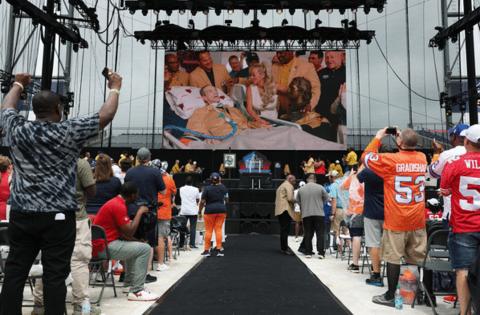Commentary: Technology is improving the lives of people with ALS
Published in Op Eds
The current Chicago professional sports landscape certainly looks like an arid desert, but fans encountered a rare oasis recently when former Chicago Bears Devin Hester and Steve McMichael were inducted into the Pro Football Hall of Fame.
Hester is arguably the greatest kick returner in NFL history and McMichael was an anchor on the vaunted defense of the 1985 Super Bowl champions, a defense regularly invoked in arguments over the league’s best ever.
With all due respect to Hester, this story belongs to McMichael: It is not that the formidable defensive tackle was admitted to the Hall of Fame, but that he survived to see it.
Three years ago, McMichael developed amyotrophic lateral sclerosis, a progressive, ultimately fatal motor neuron disease that robs people of muscle control, rendering them paralyzed but sparing their eye movements and leaving their minds intact. They generally die of lung complications because their muscles can no longer support coughing, which leads to pneumonia, and ultimately results in the inability to breathe, causing death by suffocation.
ALS currently affects about 30,000 Americans; in sports figures it may be associated with past head trauma. Although there is no cure, McMichael and others like him are receiving help from new assistive technologies that are prolonging their lives and improving their quality of life as well.
ALS is commonly known as Lou Gehrig’s disease because the great New York Yankee first baseman was the first notable figure to be diagnosed with the disease (the subject of his famous “luckiest man” speech at Yankee Stadium in 1939). Gehrig lived less than two years after his diagnosis because tracheostomies, where suctioning can clear the lungs, were not performed, and portable ventilators, which “breathe” for patients, had not yet been invented. McMichael is fortunate to benefit from both — and more.
Although the survival time of ALS patients is reported to be two to five years after diagnosis, consider two patients whose cases illustrate how important assistive technology is in ALS: Stephen Hawking and Steve Gleason. Hawking, one of the world’s great theoretical physicists, lived 55 years with the aid of a tracheostomy, ventilator and equipment devised by Britain’s National Health Service. Gleason, a former safety for the New Orleans Saints, has had ALS since 2011 and is one of the most impressive successes of assistive technology.
Gleason worked with Congress to pass the Steve Gleason Act, which ensures that eye tracking and speech-generating medical devices are available for patients who require them. He has been working with Microsoft to develop new generations of these tools. He founded Team Gleason, which has been instrumental in work on software for patients who can’t speak and that can be driven with the eyes. Besides being a spokesman for ALS patients, he has climbed Machu Picchu and fathered two children.
“I can do anything an ordinary person can do on a tablet computer — talk, videoconference, text, stream music, buy Christmas presents online, pay bills, tweet,” Gleason says, describing his progress.
As American medicine advances at the same time as the population ages, there are more people surviving today with strokes, Parkinson’s disease, and other neurologic and muscular diseases. Along with this are thousands of young patients with spinal cord trauma or brain injuries who could participate in daily life through the latest hardware and software. The technology is crucial in helping both the young and old, making social interaction available to patients and allowing them to combat the omnipresent threat of isolation and loneliness.
These patients often need customized devices because standardized equipment may not be the right fit — tablet screens are often too small and patients may not have the dexterity or strength to use smartphone keys. But specialized therapists are also required to help people with mobility (physical therapy), to aid those with breathing problems (respiratory therapy), help with communication (speech therapy), and return people to routine activities (occupational therapy). The race to normalize daily life for ALS and other patients creates limitless careers and business startup opportunities for tech-savvy innovators.
Medicine’s early adaptations to the computer age were undeniable advances in patient care: devices such as the electronic medical record, the computerized scanner and robotic surgery. Yet all had the perverse effect of minimizing interaction between caregivers and patients. The use of computers, tablets and smartphones is only now emerging for patients with neurologic diseases, vision problems and other disabilities to help them integrate back into society.
All this is occurring while physician-assisted dying has become an increasingly popular option in Western Europe, Canada and the United States. Yet the lesson of Gleason and Hall of Famer McMichael is that, at least where ALS is concerned, assistive technology, rather than assisted dying, is the superior approach.
_____
Dr. Cory Franklin is a retired intensive care physician and the author of “The COVID Diaries 2020-2024: Anatomy of a Contagion As It Happened.”
_____
©2024 Chicago Tribune. Visit at chicagotribune.com. Distributed by Tribune Content Agency, LLC.




























































Comments